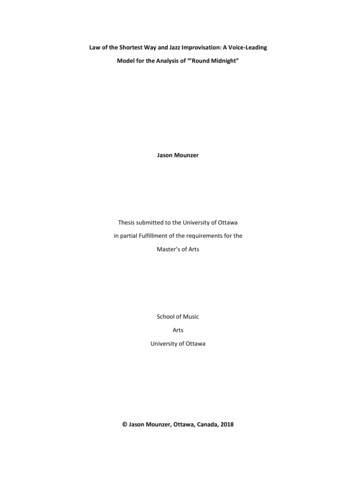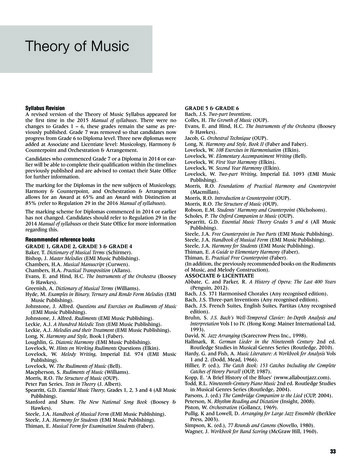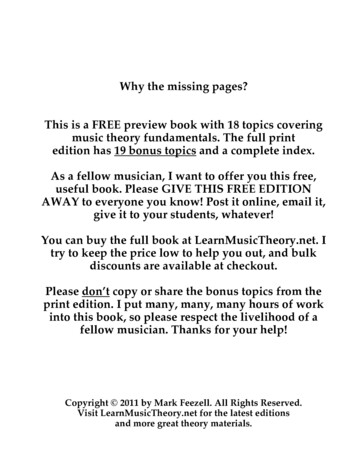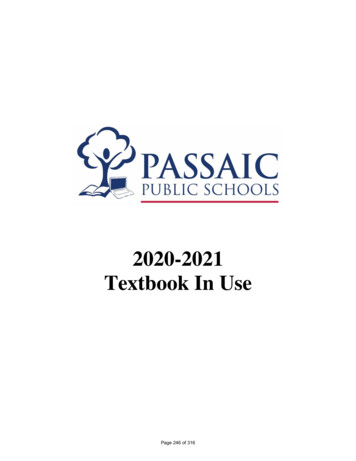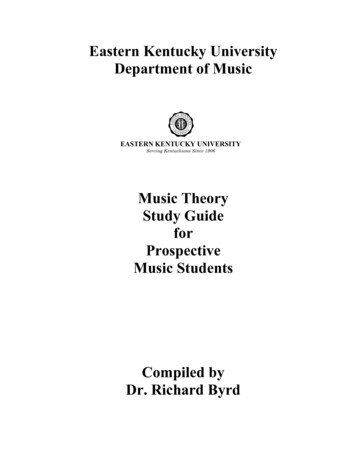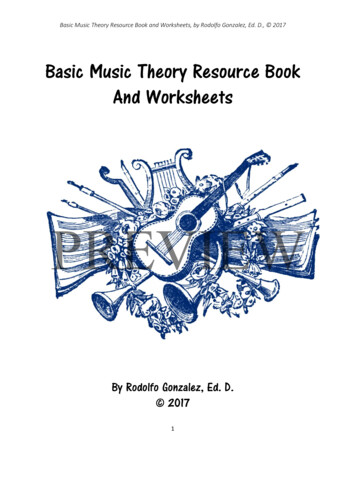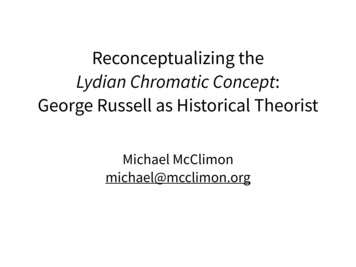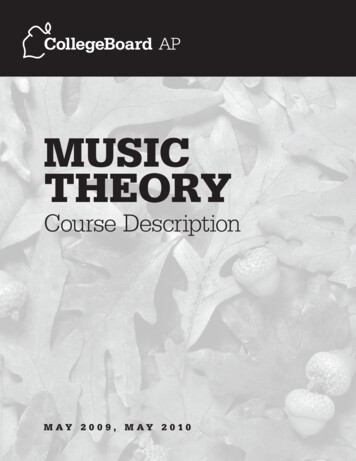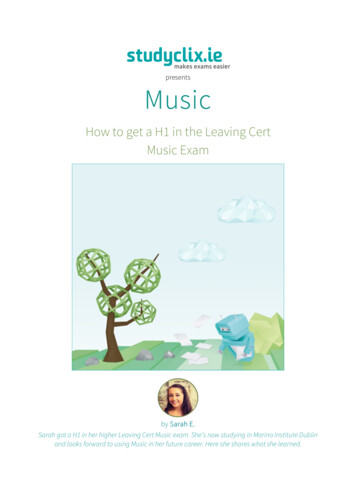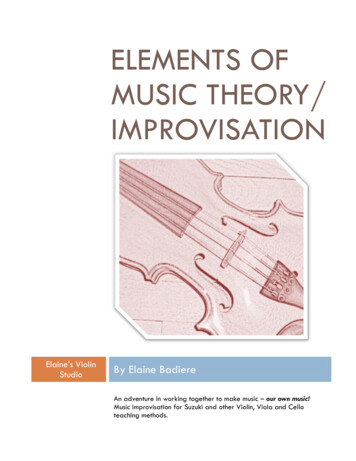
Transcription
ELEMENTS OFMUSIC THEORY/IMPROVISATIONElaine’s ViolinStudioBy Elaine BadiereAn adventure in working together to make music – our own music!Music improvisation for Suzuki and other Violin, Viola and Celloteaching methods.
Elements of Music Theory/ ImprovisationThis document was created by Elaine’s Violin StudioPlease direct all questions to Elaine BadiereFor electronic correspondence, please use the form found at:http://www.elainesviolinstudio.com/?page id 13 2014 Elaine BadierePage 2
Elements of Music Theory/ ImprovisationPREFACESome may be wondering, why would a Suzuki violin teacher launch into Elements of MusicTheory/Improvisation? After all, don't some Suzuki teachers even avoid teaching the notereading part of Music Theory? Some may, but here is my little personal contact with Dr.Suzuki story.The last year that Dr. Suzuki came to the American Suzuki Institute in Steven's Point,Wisconsin, I was there. When we were given a chance to ask our questions, I asked aboutsight reading musical notation, as there was at that time, some question as to whether weshould be teaching this skill. He inquired as to whether the children in my area learned toread musical notation at school. I replied that not always did they learn this skill at school.Where upon, he brightened and said,“WHATEVER THE STUDENT NEEDS TO KNOW, THE TEACHER NEEDS TO TEACH!”This has been my guiding principle in all of my teaching. So, because Improvisation is moreand more a required skill for young musicians, I propose that we need to introduce it earlyon, as we do the other skills they need to develop. Let's take on the challenge of thepresent!In this book, the beginning exercises are set up to be presented aurally to the student,Suzuki teaching style. We do get to exercises that obviously need to be presented in theprinted form. The student needs to be at ease with note reading for these presentations tobe meaningful. The teacher is in a position to advise on this matter. This presentation is notmeant to be a full coverage of the broad subject of improvisation. It is merely a way toget fairly young kids and others to be familiar with the basic tools of improvisation andhow to use them, or we could say, get started.Page 3
Elements of Music Theory/ ImprovisationContentsPREFACE . 3CONTENTS . 4HELLO . 5THE ELEMENT OF MAKING IT UP . 6Using what is at hand . 6Notes and degrees of major scale . 8Major Scale with words to sing the scale: . 8Letter names of notes of scales:. 8Imaginative mood settings for improvisation: . 8SETTING UP A BEAT. 9IMPROVISATION OF AN ACCOMPANIMENT. 10SCALES AND ARPEGGIOS . 11PATTERNS AND KEYS . 20TWINKLE CHARTS . 21LIGHTLY ROW CHARTS . 26GO TELL AUNT RHODY CHART . 28IMPROVISING ON A MELODY I . 29IMPROVISING ON A MELODY II . 32USING THE DORIAN CHURCH MODE . 34FIDDLE STYLE . 34COMPOSE . 34TRANSPOSITION . 35PATTERNS AND KEYS . 36KEY SIGNATURES . 38FAREWELL . 39RECOMMENDED RESOURCES . 39COMPOSITION PAPER . 40Page 4
Elements of Music Theory/ ImprovisationElements of Music Theory/ImprovisationBY ELAINE BADIEREHELLOWe are about to start an adventure in working together to make music, not music writtenby somebody else and we play it. NO! We are going to make our own music!If we want to build a house, we must build a foundation under it to hold it steady andsolid. In music, we could think of the foundation as the sound waves or vibrations that hitour ears and are picked up by our brains and interpreted as the sound of whatever issetting up the vibrations. Upon that foundation we have a floor – the resonances anddissonances that these vibrations set up. Different cultures have used these resonances anddissonances in different formations. The most used formations here in North America arethe major and minor scales. The notes of these scales provide us with the building blockswe are going to be using. We can put them together, pull them apart and put themtogether again much like we would Lego pieces.So, let's get started!Page 5
Elements of Music Theory/ ImprovisationTHE ELEMENT OF MAKING IT UPUsing what is at handOne of Mr. Webster’s definitions of “improvise” is, “to use what is at hand”. The first thingsat hand are open strings, Violin E, A, D, G. Viola and Cello, one octave apart A, D, G, C.So we do have overlap. Now, let's make sure we have something at hand to use, such asone octave of notes in the formation of a major scale. The young child doing the Suzukiviolin method, can sing a little song first; The little train goes up the hill. The little train comes down again.These words correspond to the notes of a major scale, first going up, then coming down.Singing the words to the notes of a major scale is quite easy. Once students can sing itthey can learn to play it easily. The first one octave scale they learn to play on violin is Amajor, and D major for viola and cello, each starting on the second highest open string ofeach instrument:A or D open string, 1, 2, 3 E or A open 1, 2, 3 (with fingers 2 & 3 together for the halfsteps) works for violin and viola. For Cello, Open 1, 3, 4 works.When the student can ascend and descend the A or D major scale comfortably he/she isready to start to learn Twinkle Twinkle, but also to start to use the notes at hand to makeup something. I like to let the student start to learn Twinkle. Sometimes this process seemsto move a little slowly, in which case I can introduce improvisation as something new.However the introduction of improvisation can happen any time, to add new interest, tounderstand the workings of Music Theory, or just for fun. At this point there is only onerule:“Start on the key note and end on the key note,” (in this case A or D open string).In between the start and end notes, do whatever you like, for as long as you like, using thenotes of A or D major scale.So now the student is learning a given melody, Twinkle Twinkle. He/she is also learninghow to mix up the notes of the A or D major scale in different ways to make his/her ownmelody. There is further a very basic thing going on. The youngster is getting the feel of ascale/key/home playing field! These are the first steps!Page 6
Elements of Music Theory/ ImprovisationWhen the scale is comfortable, the student can easily transfer the fingering and bowingover a string and repeat it all in D or G major. Then another transfer over a string bringsus to G or C major. As each scale becomes comfortable, improvisation within the newboundaries becomes possible.Now, students can also transpose Twinkle Twinkle, the same way. They may well have goneon into the next several songs in the book by this time. That’s OK too. Each musicalselection introduces something new in the technique of violin, viola or cello playing which inturn gives us something more at hand to use in improvisation.As the student proceeds through the first half of the Suzuki Violin/Viola/Cello SchoolVolume 1, we have the chance to teach them the names of the scale notes they areplaying on the their instrument. It is advantageous to establish this step before they start tolearn the names of the notes on the staff, so that the connection between the symbols onthe page and the instrument geography is better facilitated.Students can start to learn the notes on the staff by means of a book called I Can ReadMusic, Volume 1 for violin/viola/cello, by Joanne Martin. As the student becomes wellestablished in the note reading exercises, he/she can start to follow the printed music inthe Suzuki book with his/her finger, while listening to the recording. We still have conceptdevelopment through the ears, as well as getting used to following printed notes. This waythey can ease into using the printed page gradually. They can also develop the ability tohear what they see.In the second half of the Suzuki Violin or Viola School Volume 1, the student learns 2 newfinger patterns, which give us new notes. This allows us to start doing 2 octave scales. I liketo assign the improvisation exercises in the lower octave and higher octave separately asthe finger patterns are not the same in both octaves. This allows the student to adjust tothis difference. I recommend another book called String Class Fingerboard Geography, byBarbara Barber, to facilitate and clarify this sort of learning.Back to improvisation! A fun and useful addition to this game of improvisation, when thestudent is at ease with the process is: what would a sunny day family picnic sound like? Or,what would a thunderstorm sound like? Imagination is the stuff of improvisation! I reallylike to take advantage of this time and stage of growth to develop a readiness to makeup, improvise, and set up imaginative settings and moods.By this time, can you count all the building blocks we have ready to use?We have the concept of notes in scale formation, on paper and in the ear. We also havefolk songs (in the Suzuki books), which give us musical phrases and melodies, on paper andin our ears. Following is a review of some of these building blocks.Page 7
Elements of Music Theory/ ImprovisationNotes and degrees of major scaleMajor Scale with words to sing the scale:Do Re MiIII IIIFaIVSolVLa Ti Do Do TiVI VII VIII VIII VIILaVISolVFaIVMiIIIReIIThe li - ttle train goes up the hill. The li - ttle train comes down a -DoIgainLetter names of notes of scales:A B C# D E F# G# A A G# F# E D C# B AD E F# G A B C# DG A B C D E F# GCDEFGABCD C# B A G F# E DG F# E D C B A GCBAGFEDCAll this is absorbed little by little as appropriate.Scales are made up of tones and semi-tones (Canadian usage), or whole steps and halfsteps (American usage). For violinists and violists this means: fingers apart for tones/wholesteps and fingers together, (sometimes scrunched or pushing each other out of the way) forsemi-tones/half steps. This idea, which is developed in practicing the scales, can helpintonation immensely.A big part of improvisation is imagination, just like when we build a house with blocks orLego. So, along the way, let’s stop often and reset our imagination.Imaginative mood settings for improvisation:These may be suggested to students and students can be encouraged to create their ownlist of imaginative moods. Thunder storm Sunny day or a picnic A visit to a friend’s house Playing with my puppy/kitty Plus anything else you can come up with Page 8
Elements of Music Theory/ ImprovisationSETTING UP A BEATWhen the student feels ready and comfortable, we can put a beat with what they areplaying in the improvisation exercise/game. Actually, if we have been playing 2 nd violin,viola or cello parts or guitar or piano accompaniments with the Suzuki pieces he/she islearning, this step is rather easy. They already have the feel for the beat. We can showthem how we might put a beat with some made up phrase or two, by using our feet to tapout a straight beat, preferably a rather slow beat so as not to intimidate the youngster.We can show the parent how to give the student a beat by clapping or slapping the kneesor combining the two; it is again important to give a straight beat, and keep it rather slow.The teacher or parent, for best results, should just provide the beat, without asking for thisor that during this exercise. The child needs a chance to settle into the beat. That isenough for a while.Later, when the student is ready and eager, patterns of one quarter note followed by twoeight notes, for example, or any other patterns of two, three or four beats can be set up.These may be expressed by tapping, clapping or by means of a Dr. Beat metronome orsimilar device. Also the teacher can play the pattern on the key note of the scale beingused, or in a chordal pattern. At first, of course, take easy paced beats to let the studentwork into it at his/her own pace. This way the student can take on simple meter, then workinto compound meter, as simple or complicated as desired.Page 9
Elements of Music Theory/ ImprovisationIMPROVISATION OF AN ACCOMPANIMENTNow we come to a concept that needs a little more facility with our building blocks: chordsthat are built on various notes of a given scale. See the major scale and chord/ arpeggiosets, page 11 and on. The letters above the chords are the chord names, the name of thenote upon which the chord is built. The Roman Numerals under the notes indicate therelationship of that chord to the key being used, as in, it is built on the first, fourth or fifthnote, etc. of the scale/key. See also page 8.Next we can give them a simple accompaniment pattern. When they have internalized thepatterns by chord numbers and sound function, and can play the indicated chord patternsby memory/ear we can move on.Let's start with Twinkle Twinkle. This is a set of notes that the Suzuki student is more thanwell acquainted with. So now we can add a new element from the chart for TwinkleTwinkle, and ask him/her to play the indicated chord patterns, fitting into the indicatednumber of beats. The given pattern of two eighth notes to the beat will work best to start.If the teacher or other player can play Twinkle an octave lower, the student can begin withthe pattern starting on open A or D string. He/she will do the one beginning on the G or Cstring, when ready. Then he/she can trade back and forth.In the following pages, you will find the scale and arpeggio sets for A and D major, D andG major, G and C major. The Suzuki student who has added Twinkle D or G major, and Gor C major from early on, can probably add in the accompaniment exercise in these keys,fairly easily.The student may be in Suzuki Book 2, 3 or 4 or farther by now. It alldepends on the student's interest and when he/she started theimprovisation project.Page 10
Elements of Music Theory/ ImprovisationSCALES AND ARPEGGIOSExercise 1Page 11
Elements of Music Theory/ ImprovisationExercise 1Page 12
Elements of Music Theory/ ImprovisationExercise 1Page 13
Elements of Music Theory/ ImprovisationExercise 2Page 14
Elements of Music Theory/ ImprovisationExercise 2Page 15
Elements of Music Theory/ ImprovisationExercise 2Page 16
Elements of Music Theory/ ImprovisationExercise 3Page 17
Elements of Music Theory/ ImprovisationExercise 3Page 18
Elements of Music Theory/ ImprovisationExercise 3Page 19
Elements of Music Theory/ ImprovisationPATTERNS AND KEYSNext we can use a simple combination of the chordal tones to form a basicaccompaniment pattern, I, IV, V7. The same finger patterns would be used on differentstrings to get the different keys.See Transposition Section, for an extended key lay out of the chart.E. BadierePage 20
Elements of Music Theory/ ImprovisationTWINKLE CHARTSNow we come to the charts for Twinkle Twinkle, laid out for Violin, Viola and Cello in theirkeys, A and D major, D and G major, G and C major. Move from one key to the next onlywhen the current key is comfortable. Sometimes the student needs the teacher to play themelody a measure at a time with him/her until he/she gets the feel for how this works.When the Twinkles are comfortable, try doing the folk songs, Lightly Row and Go Tell AuntRhody as indicated. When that is comfortable, can you transpose these songs using thekeys and chords we used for Twinkle?Exercise 4Page 21
Elements of Music Theory/ ImprovisationExercise 4Page 22
Elements of Music Theory/ ImprovisationExercise 5Page 23
Elements of Music Theory/ ImprovisationExercise 5Exercise 6Page 24
Elements of Music Theory/ ImprovisationExercise 6Page 25
Elements of Music Theory/ ImprovisationLIGHTLY ROW CHARTSExercise 7Page 26
Elements of Music Theory/ ImprovisationExercise 7Page 27
Elements of Music Theory/ ImprovisationGO TELL AUNT RHODY CHARTExercise 8Page 28
Elements of Music Theory/ ImprovisationExercise 8IMPROVISING ON A MELODY IPage 29
Elements of Music Theory/ ImprovisationAfter playing an accompaniment gets easy, the student may like to try combining themelody with the accompaniment chord structure to try improvising on a melody. Use thenotes of the chords to add notes around the melody. As with all the other exercises, startwith a simple idea, as in two eighth notes to one quarter note. In the following examplethe Violin, Viola or Cello 1 part is the first phrase of the Twinkle melody and the Violin,Viola or Cello 2 part is an improvisation. Now can you continue this idea, in your ownway?Exercise 9Page 30
Elements of Music Theory/ ImprovisationExercise 9Page 31
Elements of Music Theory/ ImprovisationIMPROVISING ON A MELODY IINow we are going to consider the use of rhythmic variants in improvising. The Suzukistudents are already on the path with this idea. They did the Twinkle Variations in thebeginning of their studies. Twinkle Twinkle, employs the same note, two beats at a time,either two quarter notes or one half note all the way through. So the two beat pattern israther easy for the student to use. Any Suzuki student will recognize the pattern of oneeighth note and two sixteenth notes from the Twinkle variations. What is different here isthat this melody is not the two beat note pattern of Twinkle. There are dotted quarternotes and eighth notes. So now the eighth and sixteenth note pattern has to follow themelody. Seeing and understanding this on paper is one thing. Can you do it? Easily? This iswhy it is good to practice chordal exercises and rhythmic exercises separately until onehas enough ease with each to start putting them together, in his/her own imaginative way.Exercise 10Page 32
Elements of Music Theory/ ImprovisationExercise 10Page 33
Elements of Music Theory/ ImprovisationUSING THE DORIAN CHURCH MODEThe minor scale is not dealt with in Book one of the Suzuki School, but there is a funexercise the student can do because he/she does learn in the second half of the book, howto play all the natural notes on the D and A strings as in fingers 1 and 2 together. Thesenatural notes, D open to D on the A string, form the Dorian Church mode. It is fun to playthese notes as a scale and then use them to make up/improvise something, the same waywe did with the major scales in our first exercise.FIDDLE STYLEOne tool of improvisation is the use of different styles of music. Kids often find FiddleStyle fun to do and it can be incorporated into improvisation. Can you do a classicalmelody in fiddle style? A very good study of fiddling for kids is: Children's FiddlingMethod, by Carol Ann Wheeler. She gives guitar chord indications for accompaniments.The teacher can help the student, if need be, to develop his/her accompaniment patternsfrom these chords.Incorporating all three instruments: Basic Fiddlers Philharmonic by Dabczynski and Phillips.COMPOSEOnce the student knows the notes of his/her first three basic scales, both on the instrumentand on paper, and can use a time signature, he/she may want to try composing a littlemelody, and write it down. Usually this level of mastery of the basic notation skills isdeveloped in the first Volume of the I Can Read Music book mentioned earlier. If thestudent enjoys making up little tunes improvising, often a little composition is the nextchallenge he/she is eager for.Page 34
Elements of Music Theory/ ImprovisationTRANSPOSITIONTo transpose is to take a melody or piece of music from one key and put it into anotherkey. We have already set up this concept. We have dealt with several aspects of movingbetween A major, D major and G major for the violin and D major, G major and C majorfor viola and cello; these are the basic first position major keys for each instrument.Next, we will discuss getting into slightly more complex transposition. The accompanyingchart, Patterns and Keys, shows the relationship of the chordal patterns and keys thestudent has used up to this point, and likely quite beyond. This simple pattern can be donestarting on open A or D, D or G and G or C strings. Then it is given starting with fingernumber one on G or C string, first position. The other suggested keys are achieved bymoving to half position, second and third positions. Then again the pattern is given startingwith finger number one on the D or G string. Again the suggested keys are achieved bymoving to the previously mentioned positions. This works for violin and viola. Cello needs alittle more shifting within each key or as given here. Obviously, these positions cannot beused until they are learned. So, we can use the chart progressively. These patterns wouldbe used in accompaniments and also improvisations on a melody.There is, of course, the matter of transposing the basic melody. Take Twinkle Twinkle, forexample. You can start it on three of the open strings on you instrument. Try starting onfinger #1 on any of the strings you have used to begin with before. Violinists and Violistsuse fingers #3 & 4 together for the half step rather than #2 & 3 as when we start on theopen string. Cellos will need some shifting within each key. When you get the melody setup in this form, you can move to different positions and do it in different keys. Dr. Suzukidid this with the little melody Perpetual Motion, which he took from Book 1 and used in hisbook Position Etudes to acquaint the student with the feel of each position up to 7thposition.Also, it is probably best to start with melodies well known to the student, so that he/shecan easily monitor the results. When a melody is comfortable in a new key, one can tryaccompaniments and then improvising on the melody.The chart, Key Signatures, is designed to allow the student to clarify and monitor his/herprogress in transposing melodies or chordal patterns.TPage 35
Elements of Music Theory/ ImprovisationPATTERNS AND KEYSExercise 11Page 36
Elements of Music Theory/ ImprovisationExercise 11Page 37
Elements of Music Theory/ ImprovisationKEY SIGNATURESORDER OF SHARPSO R D E R O F F L AT SExercise 12Page 38
Elements of Music Theory/ ImprovisationFAREWELLAnd so, my friends, we come to the end of this little collection of improvisation buildingblocks. You may want to keep this booklet handy for reference because now you aregoing to find other songs and ideas on which to try these building blocks. You will findpeople who want to build music along with you. Look for people who are doing the kindof music you would like to do. Listen to them, learn from them and be open to sharing whatyou are doing with them. Remember that music can be a very great blessing to thosearound us! Be generous! Music is like the lives we live. What is lived and played from loveis a blessing!RECOMMENDED RESOURCESBarber, B. (2008). Fingerboard geography: Violin : An Intonation, Note-Reading, Theory,Shifting System, Volume 1. California: Alfred Music Publishing.Dabczynski, A. and Phillips, B. (2007) Basic Fiddlers Philharmonic: Old-Time Fiddle Tunes.Van Nuys: Alfred Publishing Co., Inc.Martin, J. (1991). I Can Read Music: A Note Reading Book for Violin Students (Volume 1).Miami: Sammy-Birchard Inc.Wheeler, C. A. (1992). Children’s Fiddling Method. Mel Bay Publications, Inc.Page 39
Elements of Music Theory/ ImprovisationCOMPOSITION PAPERPage 40
Elements of Music Theory/ ImprovisationPage 41
Elements of Music Theory/ Improvisation Page 5 Elements of Music Theory/ Improvisation B Y E L A I N E BA D I E R E HELLO We are about to start an adventure in working together to make music, not music written by somebody else and we play it. NO! We are going to make our own music!
